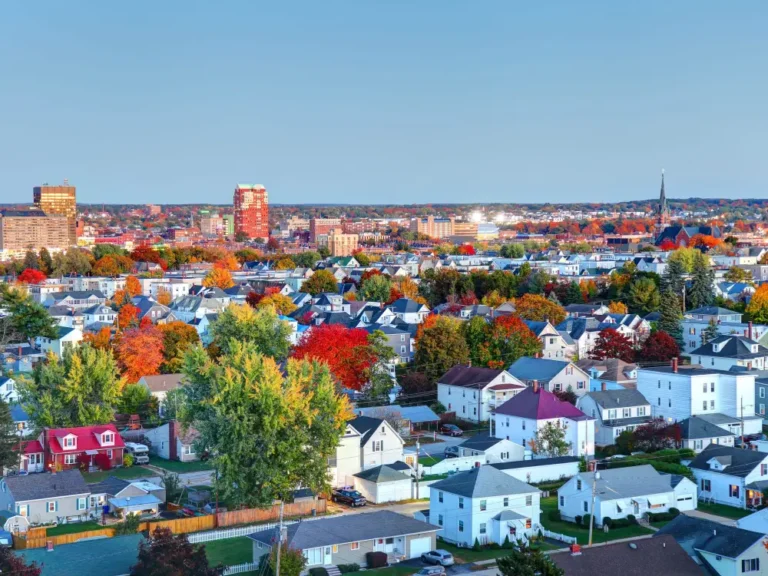Bright lights, small paychecks

Americans who live in big cities used to make more money than folks in the sticks. Not anymore.
Cities may be crowded, dirty, loud, and expensive, but they’ve always offered one clear advantage over America’s rural areas: more money.
Workers in urban centers have traditionally raked in significantly more than their rural counterparts, a phenomenon known as the urban wage premium. For decades, both college-educated workers and those without college degrees reaped the rewards, even when factoring in the higher housing costs that come with city dwelling. Everyone benefited from the job opportunities and plumper paychecks that cities could provide.
But the golden promise of cities is cracking. In the past decade and a half, a steep rise in housing costs has flipped the equation for lower-skilled workers. A study published last year in the Journal of Public Economics found that instead of enjoying an urban wage premium, non-college-educated workers now effectively pay a penalty for living in a city. Based purely on dollars and cents, it appears they might be better off moving someplace less crowded. While college-educated workers are doing better, they’re still moving to cities at a slower clip than in decades past, a sign of big trouble for the places that once promised prosperity.
In a recent essay for the bipartisan Economic Innovation Group, the economist Stan Veuger, one of the study’s coauthors, argued that the problem is simple: Cities aren’t building enough housing for all the workers who want to live in them. Places like San Francisco and New York City have fallen victim to strict zoning laws and tedious permitting processes that make it incredibly difficult to build new housing. This leaves a growing population to scramble for fewer and fewer homes, bidding up the prices of what is available. Cities are supposed to offer better job opportunities and wages than smaller outposts, but they’ll lose that edge if people can’t afford a place to lay their heads. There’s hope, though. Forward-thinking cities like Minneapolis, Nashville, and Austin offer proof that building more homes does — shockingly! — ease prices for residents. The steps they’ve taken could offer a playbook for leaders in other cities who want to avoid becoming the next San Francisco or Seattle.
College grads may be better off working in cities for now, but there’s no guarantee that will always be the case. And as more non-college-educated people get priced out of cities, everyone suffers: Restaurants struggle to find workers, rates of homelessness rise, and basic services go understaffed. Office jobs can’t power downtowns all on their own. If cities stop working for noncollege workers, they may very well stop working for everybody.
“It’s not necessary to have these inflated home prices,” Veuger told me. “We’re just making housing artificially expensive by restricting construction in the places where people want to work and want to be the most productive. And that affects everyone.”
When lots of workers and employers cluster together, they create a positive feedback loop that lifts everyone. People have better odds of landing a job in their desired field, while companies can pluck employees from a larger talent pool. This is why cities often turn into hubs for specific industries, like San Francisco and software companies or Detroit and auto manufacturing. Workers want to be where the jobs are, and the Apples and Fords want to be where the workers are, especially if those workers have useful skills. This is also why, as my colleague Aki Ito writes, big cities offer a kind of “career insurance.” Working in an area with lots of jobs, she writes, “sets you up for success to land your next job — and the job after that.”
In many cases, city living also means bigger paychecks. Economists don’t all agree on why the urban wage premium is a thing, but there’s plenty of evidence that it exists: Workers who live in big cities like Chicago or Seattle tend to earn much more — without factoring in expenses — than similar workers who live in smaller places. The Harvard economist Ed Glaeser told me that workers who move to cities not only get a raise but often see their wages increase at a faster rate in the future. The problem for lower-skilled workers, though, is that this urban wage premium is shrinking. One leading theory, promoted by the MIT economist David Autor, is that the job market has changed in ways that hurt noncollege workers, with well-paying clerical or admin jobs shifting overseas or giving way to software. The urban wage premium hasn’t disappeared for these workers — in 2019, workers with only a high-school diploma or less earned about 10% more by living in dense areas than they would have by living in rural areas. But that’s not nearly as strong as it was back in 1970, when the premium was about 35%. On the flip side, white-collar workers in 2019 still earned about 50% more by living in the biggest cities compared with the most rural areas. Concrete jungles offer the kinds of jobs that smaller cities or towns simply don’t have, and highly educated workers still benefit from living where these opportunities are plentiful (especially since fully remote jobs are a lot harder to come by these days).
The problem with these figures, though, is that people can’t just stash away their entire paychecks. While city dwellers may earn more, the cost of living in these areas is also higher. So Veuger and his coauthors, Philip Hoxie and Daniel Shoag, went a step further by factoring in the most important of these costs: housing. They wanted to see if the big-city bargain still worked as promised — if higher wages were enough to justify the steep sums city workers were shelling out each month to keep a roof over their heads. They found that back in 1970, wages (minus housing costs) for all kinds of workers were about 13% greater in high-density places than they were in low-density places. But that’s not the whole story. The fortunes of college-educated and noncollege workers diverged significantly; by 2000, noncollege workers basically netted the same amount in high- and low-density places. Rising housing costs had erased their urban wage premium. And by 2019, these workers appeared to be better off moving out of the city.
Cities need all kinds of workers, not just lawyers and software engineers, to function.
There are benefits of living in cities that aren’t captured in this data, to be sure. Poorer residents, for example, have a better chance of getting around without a car in a city than in a suburb or rural area, saving them money. The plethora of job opportunities — that “career insurance” — may provide the peace of mind that smaller places don’t. Or they may see more upside in their wages, a better chance of making more money in the future. At the end of the day, though, everyone would be better off paying less for housing. And the shift for noncollege grads isn’t bad for just those individuals. Companies want to be in highly productive places with lots of workers, but the implication of these findings is that low-skilled workers end up leaving for less productive locales. And cities need all kinds of workers, not just lawyers and software engineers, to function. They also risk losing population: New York City, for instance, had a net loss of 160,000 residents from domestic outmigration from mid-2022 to mid-2023. Even the highest-skilled workers are moving to bigger cities less frequently, implying that they’re deterred by expensive housing — even if they might earn more by relocating there.
“There will always be people who are saying, ‘Look, I don’t want to pay these high home prices,'” Veuger told me. “At the margins, there are people who are not moving to the places where they would be most productive.”
The root causes of this mess are no secret. Cities have been underbuilding for decades, crimping housing production via strict zoning rules and lengthy review processes that make new construction either more expensive or impossible. Concerned neighbors turn out in droves to public hearings where they shout down plans for new apartments and condos, complaining about traffic, noise, or a change in the “neighborhood character.” Elected officials also play a huge role in turning down projects or slow-walking rule changes that might enable taller structures on limited available land.
“This sort of caution on the part of local governments, and delegating a lot of their power to existing residents, is kind of the heart of the problem,” Jenny Schuetz, a housing-policy expert at the Brookings Institution, told me.
Homebuilders have also been more cautious since the global financial crisis, building at roughly half the rate of the prior three decades. That’s especially bad news for millennials, who represent the largest living generation and are now in the thick of their prime homebuying years. Cities have also, in many cases, run out of the “easy” land to develop on the periphery of downtowns since workers are willing to commute only so far. The alternative to urban sprawl is infill development, or filling in the spaces between existing buildings. But that’s a lot harder and more expensive to do, so cities see less new construction than they did in their heydays.
Coastal cities like Seattle, Portland, Boston, and New York are “very difficult places to build,” Schuetz told me. The middle of the country, particularly the Sun Belt in the lower half of the US, has traditionally been more permissive of growth — think of places like Charlotte, North Carolina; Atlanta; and Phoenix. But again, those places also risk running out of easy development parcels.
It’s going to take a long time before we start building enough to catch up.
So how can cities get their mojo back? Some of it comes down to patience: In the past few years, pro-growth yes-in-my-backyard activists have scored significant legislative wins to loosen up local zoning laws and make it possible to build bigger and taller in places that previously allowed only single-family homes. But it’ll take some time — three to five years, Schuetz told me — to start seeing the effects of any new statewide rules. Ultimately, these kinds of reforms leave their mark on the housing supply over decades, not overnight.
“We’ve been underbuilding for maybe about four or five decades in high-productivity places,” Schuetz said. “It’s going to take a long time before we start building enough to catch up.”
Austin, Nashville, and Minneapolis offer examples of how pro-growth local leaders can spur more building to keep prices in check. Schuetz said Austin had encouraged a “ton of vertical construction downtown” while also trying to make it easier to do infill development in lower-density residential neighborhoods. Nashville is a similar story. Minneapolis has made changes to zoning laws to encourage apartments around light-rail stations. All three are pursuing changes to their building codes that would allow single-stair apartment buildings to stretch higher than three stories, a seemingly small change that could have huge ripple effects.
Every city has a vested interest in making sure workers of all kinds can live there. Affordable housing is good for both individual workers and huge corporations — just look at the efforts of companies like Google, Meta, and Disney to develop more homes in places where they have a ton of employees. If city leaders don’t heed the call to build more housing, they risk throwing away their built-in advantage.
“At the end of the day, if your elected leaders want to make housing happen, they will figure out ways to make it work,” Schuetz told me. “And if your elected leaders don’t want to add housing, they will figure out ways to stop it.”






